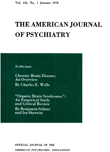Polypharmacy in Psychiatry: Patterns of Differential Treatment
Abstract
The authors studied 500 psychiatric patients who had been treated polypharmaceutically. The group was divided into thirds—one-third remaining on their original two medications, one-third on two placebos but no active medication, and one-third on one placebo and one psychoactive drug. While there were significant changes in patient pathologies, the female trend was different from the male. Analyzing the data, the authors conclude that polypharmacy, especially in men, is often an inadequate form of treatment.
Access content
To read the fulltext, please use one of the options below to sign in or purchase access.- Personal login
- Institutional Login
- Sign in via OpenAthens
- Register for access
-
Please login/register if you wish to pair your device and check access availability.
Not a subscriber?
PsychiatryOnline subscription options offer access to the DSM-5 library, books, journals, CME, and patient resources. This all-in-one virtual library provides psychiatrists and mental health professionals with key resources for diagnosis, treatment, research, and professional development.
Need more help? PsychiatryOnline Customer Service may be reached by emailing [email protected] or by calling 800-368-5777 (in the U.S.) or 703-907-7322 (outside the U.S.).



